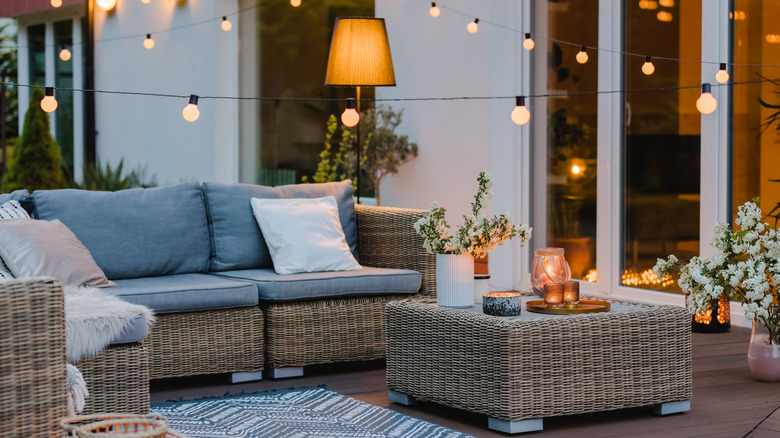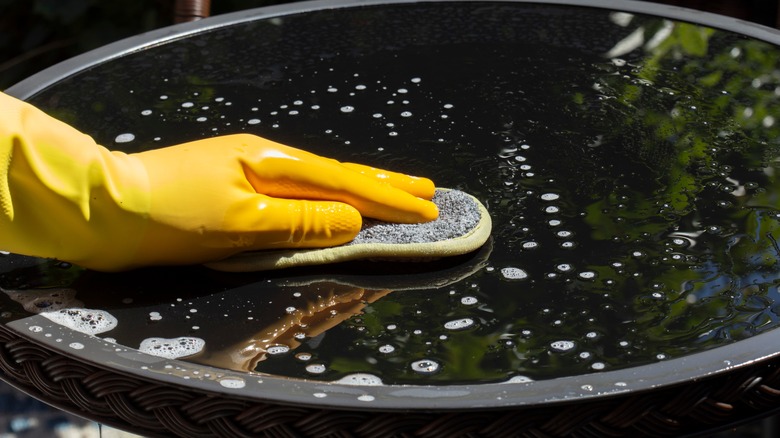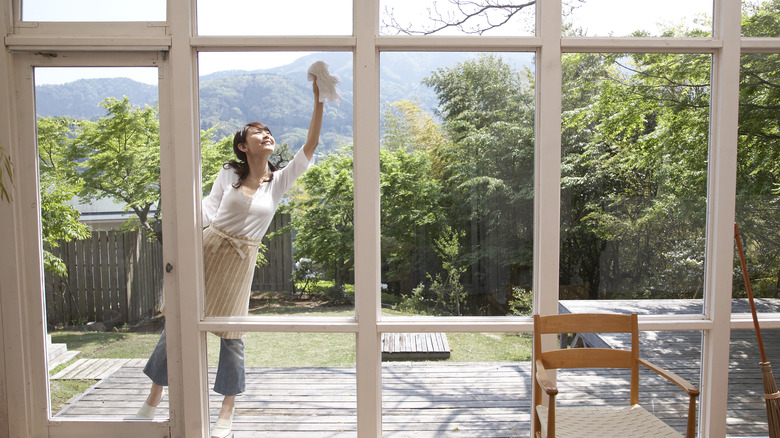Where You'll Want To Use Windex On Your Patio
Your outdoor patio furniture is exposed to the elements, dirt, and sticky fingers, so it can be a pain to clean. Yet, Windex, that powerful glass cleaner you use inside your home, can be one of the best tools for cleaning these outdoor surfaces. Though you should always follow manufacturer recommendations for this product (it's not ideal for everything), outdoor patio furniture like glass and resin tables and aluminum and plastic furniture can greatly benefit from this simple cleaner.
Windex, which is available in numerous formulas, includes various detergents and solvents. Some formulas include fragrances and ammonia as well. With Windex Original and a few paper towels or a clean cloth, you should be able to scrub away a lot of the muck that finds its way onto your patio furniture. However, there are some instances where you should think twice about cleaning with Windex – for instance, you shouldn't use it on tinted windows. Most other surfaces can become like-new with proper cleaning. Usually, all it takes is a few sprays, a bit of scrubbing, and a quick wipe-down.
What patio surfaces can you clean with Windex
Look around the patio to find a variety of surfaces you can treat with a few sprays of Windex. If you have hard plastic furniture, like compositive or resin items, you can use Windex to clean these surfaces. However, first test it out in a hidden area, like the underside of a chair, to ensure no discoloration occurs. You can also use it to clean all those glass surfaces, including the patio table, side tables, your sliding glass door, and any glass planters or fixtures. Simply spray these surfaces and use a clean cloth to wipe up the Windex and dirt.
You can use it on aluminum items, too, including awnings, fixtures, lawn ornaments, and other surfaces. However, these surfaces may require a bit more work to get them clean. Spray on a generous amount of Windex to cover the surface. Let it sit for a few minutes to allow the cleaner to penetrate into the grime, and then wipe it away. You may need to do this a second time to shine the surface to a streak-free appearance.
It may be possible to clean your patio cushions using Windex as well. It can work well on microfiber and plastics, but be sure to test a hidden area to make sure it will not cause discoloration. Also, avoid saturating these surfaces. These are just some of the surprising ways to use Windex on your patio.
Avoid using Windex on these surfaces
While Windex is truly a multipurpose cleaner, it's primarily designed for glass and may contain detergents or solvents unsafe for some outdoor materials. For instance, if you have screens or coverings made of plexiglass, don't use Windex on these surfaces. Instead, use soap and water to avoid etching into the plastic.
Windex also shouldn't be used on stainless steel grills and similar surfaces, as the cleaning agent can damage the finish. Instead, treat these with a quality stainless steel polish. You also don't want to use it on copper items, which will become discolored due to the chemicals in the glass cleaner. Instead, you can use water or a copper-specific cleaner.
Also, avoid using Windex on outdoor granite, marble, or other natural stone surfaces unless the manufacturer states it's safe. It may damage the sealant, putting the stone's appearance and protection at risk. Windex can be a powerful cleaner and is simple enough to use, but remember that it contains solvents that can cause discoloration or damage to some surfaces. However, the same applies to most glass and multipurpose cleaners.


